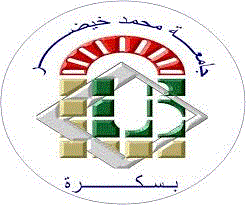| Titre : | Caractérisation morphologique des ressources génétiques caprine et suivi des performances de production d’un produit de croisement entre la race alpine et la race locale de la région aride Biskra |
| Auteurs : | Maroua Aissaoui, Auteur ; Kahramen Deghnouche, Auteur |
| Support: | Thése doctorat |
| Editeur : | Biskra [Algerie] : Université Mohamed Khider, 2020 |
| Langues: | Français |
| Mots-clés: | Caractérisation morphologique, ressources génétiques caprines, croissance, production laitière, région aride morphological characterization, goat genetic resources, growth, milk production, arid region. |
| Résumé : |
Le cheptel caprin constitue une population animale rustique possédant une assez large variabilité de caractéristiques et de performances (DE CREMOUX., 1995 ; ASH et al.,2 001 ; BOYAZOGLU et MORAND-FEHR., 2001). L’espèce caprine a pu, depuis sa domestication, manifester une importance économique dans les différents modes d’élevage (CHEMINEAU et al., 1991), même dans les régions les plus difficiles, milieux très humides ou très arides (GADDOUR et NAJARI, 2008.). Après avoir joué pendant longtemps un rôle essentiel dans la vie économique et sociale du pays en l’absence d’activité concurrente, l’élevage caprin connaît actuellement un déclin important. Cette situation rend nécessaire et urgent l’organisation de l’élevage caprin et l’amélioration de sa rentabilité. Ceci pourrait être envisagé à travers plusieurs voies, essentiellement par l’action sur les facteurs de production ou sur le potentiel génétique du cheptel, par conséquent l’une des solutions réside dans le recours au croisement pour produire de nouveaux génotypes plus productifs et performants. Le facteur limitant l’amélioration de la productivité semblerait donc être le potentiel génétique de la chèvre locale (GADDOUR et NAJARI, 2010). C’est la raison pour laquelle a été choisie l’option de croisements de la chèvre locale par des races amélioratrices de potentiel génétique supérieur, pour une meilleure valorisation des ressources locale. The Algerian goat population has an extraordinary genetic diversity but has so far been the subject of few descriptions of its populations. Thus the objective of this study is the morphological characterization of the goat populations reared in the arid region of Biskra in south-eastern Algeria, and the study of the growth performance and individual milk production of the local Arbia population, of the Alpine improving breeds and genotypes from the crossover of adsorption between these two breeds with a view to developing a strategy for improving goats in the study area. In total, 906 goats including 791 females and 115 males were phenotyped using 17 quantitative and 10 qualitative variables. Goats have been identified by sex and breeding location. The results showed that the place of breeding has a significant effect on certain external measures and qualitative morphological traits. The CPA revealed the most discriminating characters describing the size and shape of goats. Three subpopulations were obtained by the CAH. Monitoring and evaluation of growth performance revealed that litter size, sex and breed of goats significantly impacted certain growth parameters. The F1 and F2 cross kids always grow faster than the kids of the parent breeds. The evaluation of milk production, revealed that crossbred goats have shown a superiority of their performances compared to those of the parental breeds, the absorption crossover made it possible to improve the performances of milk production of the local goat. The effects linked to the genotype are significant on the variations of the majority of the physicochemical characteristics of milk with the exception of total dry matter. This study is the first step towards setting up conservation and improvement programs for local goat genetic resources threatened by uncontrolled crosses. |
Exemplaires (1)
| Cote | Support | Localisation | Disponibilité | Emplacement |
|---|---|---|---|---|
| TH/2519 | Thèse doctorat | Bibliothèque centrale El Allia | Exclu du prêt | Salle de consultation |
Consulter en ligne (1)
Consulter en ligne URL |



